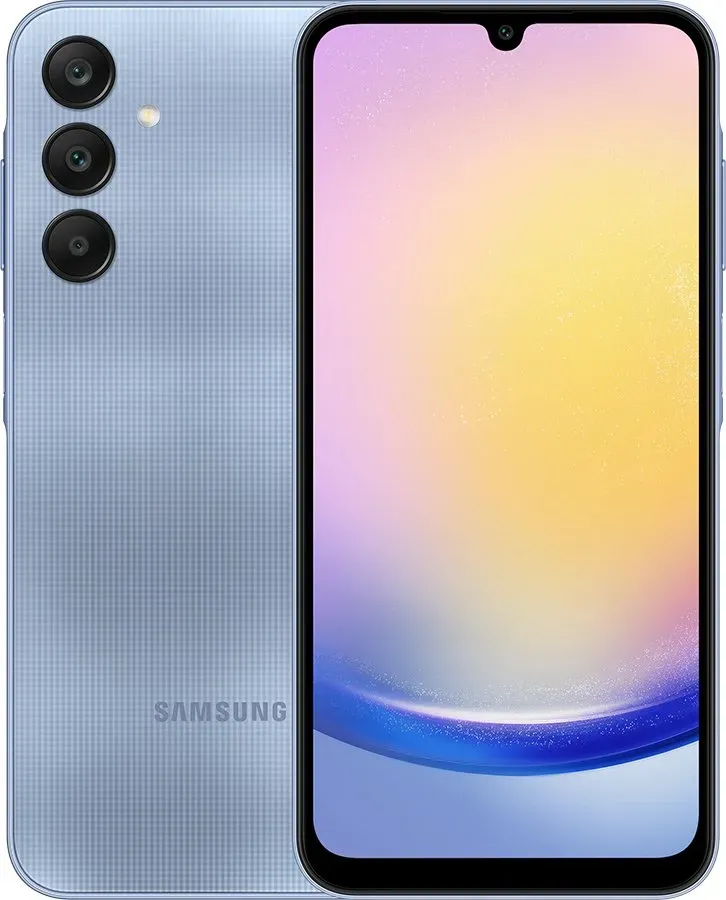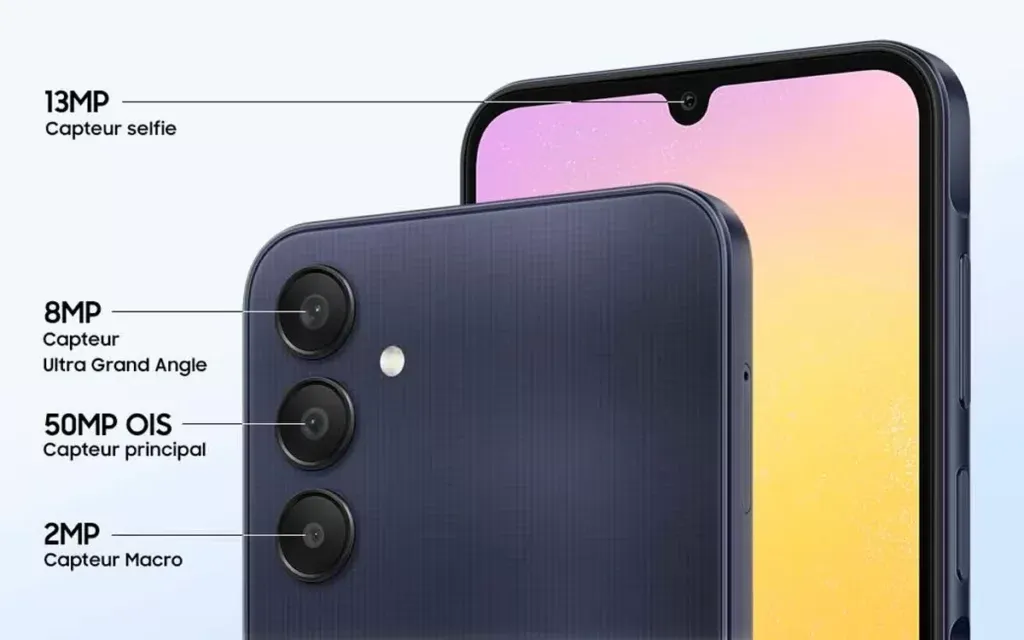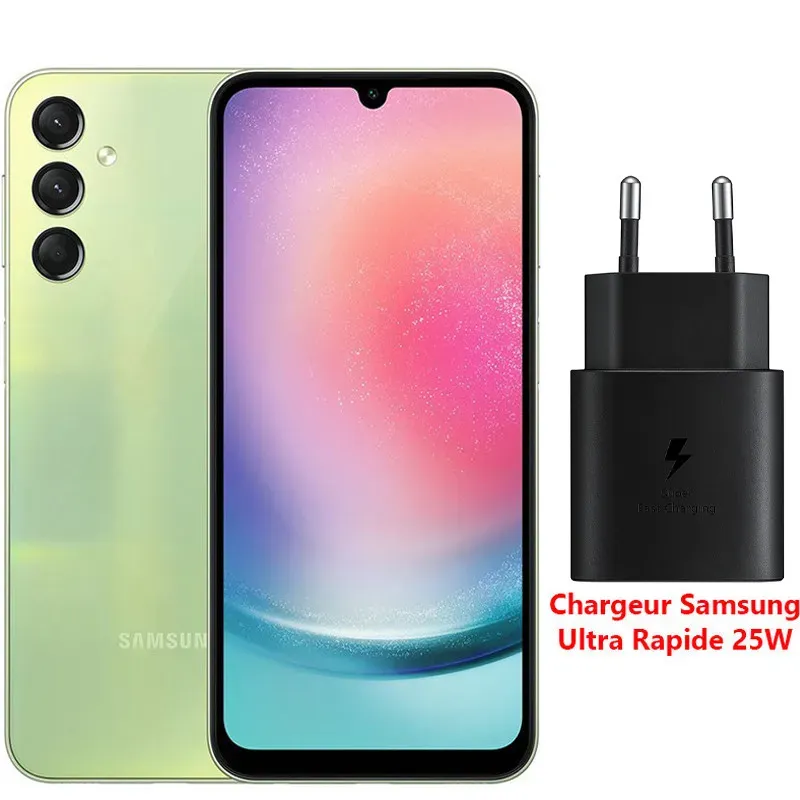Samsung continues to innovate its smartphone range with the launch of the Galaxy A25, successor to the popular Galaxy A24. With notable improvements in several key areas, the Galaxy A25 offers an improved experience over its predecessor. In this article, we’ll take a closer look at these improvements and the differences between the Galaxy A24 and Galaxy A25, for
Design and display
A more compact format

Although Samsung’s 197g Galaxy A25 is a little heavier than the 195g Galaxy A24, it has a more compact form factor that makes it easier to handle. It measures 161 x 76.5 x 8.3 mm, while its predecessor has dimensions of 162.1 x 77.6 x 8.3 mm and weighs 195 g.
Galaxy A25: a smoother, more responsive screen than the Galaxy A24
With the Galaxy A25, Samsung retains the Super AMOLED technology of the Galaxy A24’s screen and the maximum brightness of 1000 nits for the same optimal visibility even in bright conditions. The company is also keeping the 1080 x 2340 pixel resolution. Except that the manufacturer has opted for a very slight reduction in the screen diagonal, down to 6.5 inches from the 6.6 inches of the A24.

The point on which Samsung has decided to make a significant change is the refresh rate, which rises from 90 Hz on the Galaxy A24 to 120 Hz on the Galaxy A25. The aim is certainly to considerably improve the fluidity and responsiveness of the display. This then allows the Galaxy A24 screen to offer smoother movements, sharper animations, a better gaming experience and an overall more enjoyable experience when using the device.
In summary, the Galaxy A25 brings significant improvements over the Galaxy A24 in terms of its more compact design for easier handling, and its significantly higher screen refresh rate for optimised fluidity and responsiveness.
The camera
Samsung goes ultra-wide
The Galaxy A25’s camera retains the main 50MP sensor with optical stabiliser and the Galaxy A24’s 2MP macro sensor. The ultra-wide sensor, however, has changed from 5MP on the Galaxy A24 to 8MP on the Galaxy A25. The selfie camera also remains unchanged at 13MP. Samsung has therefore focused on the ultra-wide sensor to offer better quality for images with a wider field of view, such as landscapes, buildings or group scenes.

Higher resolution video
Changes have also been made to video, with the capacity increasing from 1080p recording at 30 fps on the Galaxy A24 to 4K recording at 30 fps on the Galaxy A25. Samsung is offering an enhanced video recording experience to Galaxy A25 users, enabling them to capture higher resolution video with greater sharpness and finer detail.
Platform and Memory
System software update
The Galaxy A24 runs on Android 13 with upgradeability to Android 14. This upgrade to Android 14 gives the A24 access to the latest features and software updates to bring it up to speed with its successor, the Galaxy A25. Running on Android 14, the Galaxy A25 offers a more advanced and optimised software experience.
Processing power
The Galaxy A24 is equipped with the Mediatek Helio G99 chipset (6nm), combined with the Mali-G57 MC2 GPU. With the Galaxy A25, Samsung is back with its own Exynos 1280 chipset (5) combined with an improved graphics card version, the Mali-G68 GPU.

Overall, the Exynos 1280 seems to offer faster and more responsive performance. The highly reputable Nanoreview website confirms this with a score of 40, compared with 37 for the Helio G99. But one important point is worth noting: with a score of 87, the Helio G99 gets away with more efficient battery consumption than the Exynos 1280, which scores 84.

Extended internal storage
The Galaxy A25 has the same 8GB RAM as the Galaxy A24. Samsung has just extended the internal storage options, which now go up to 256GB, whereas on the Galaxy A24 the limit was 128GB. The manufacturer has thus decided to provide users with even greater storage and multitasking capacity for a more personalised and flexible experience.
Similar battery and charging
The Galaxy A25 and Galaxy A24 carry 5000 mAh Li-Po batteries. These batteries are powered by the same 25W wired charge, so we can’t expect any significant changes to battery life, because although the Galaxy A24’s processor consumes less power, the Galaxy A25 makes up for this with its improved screen, which is more energy-efficient than the A24’s.

Price and availability
The Galaxy A24 was launched in Black, Lime Green, Blue Gradient and Dark Red for $177.99 / €163.32. As for the Galaxy A25, it is available in a number of different colours, most of them different from those of its predecessor: black, yellow, fantasy blue and optimistic blue. Although its price of $247.45 / €269.00 makes it more expensive, it is still affordable.
The bottom line
The Galaxy A25 offers some notable improvements over the Galaxy A24. Its more compact design makes it even easier to handle. Its higher refresh rate screen promises an optimised visual experience. Its ultra-wide sensor offers better shots in wider fields of vision. The phone also offers higher video resolution, a more advanced software platform, a more powerful processor and increased storage capacity. However, these improvements come with a price increase, but the phone remains affordable.
Related news
- Galaxy A15 raises the bar: Comparison with the Galaxy A14.
- Samsung Galaxy S24 and Samsung Galaxy S24 Plus: what makes the two phones different?
